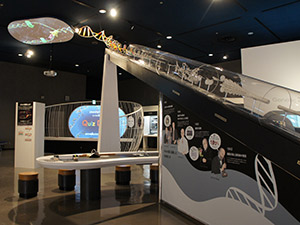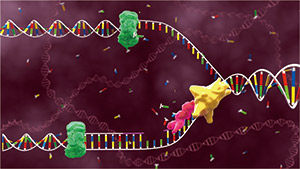Nagoya City Science Museum
TOP > Exhibition Guide > Floor Map> What Is DNA?
What Is DNA?



Purpose of Exhibition
This exhibit is designed to help you learn about the structure and functions of DNA (deoxyribonucleic acid), which plays an important role in the vital processes of all living organisms on earth.
The exhibit is made up of two main parts.
[The nature of DNA]
The large model that goes up to the ceiling shows the simple and beautiful molecular structure of DNA. Note the arrangement of the red, yellow, blue, and green acrylic bars. What kind of rules does it follow? The animation that follows the model describes how DNA is copied (replicated).
[DNA Quiz]
DNA is working inside your body's cells even right at this moment. What is it doing? Try to think about this while you enjoy the quiz.
Additional Knowledge
Have you heard often the word "DNA" recently? DNA, deoxyribonucleic acid, is the substance that actually makes up genes. You might have the idea that it is something that passes genes from the parent to their child. This is true, but it's not the only role that they play. Genes have two major functions.
First, DNA makes a copy of itself in order to ensure that when a cell divides in two, each new cell receives exactly the same genetic information. This is called "DNA replication". In the case that cells after cell division become an egg or sperm, DNA copied are passed on to the organism's child. In this way, DNA stores genetic information within the nucleus to ensure that it is passed on.
Second, the genetic information in DNA is information used to make a variety of protein molecules.
The word "protein" may make you think of eggs or muscle; however, it is an important substance for vital processes that affect the entire structure and function of the body of a living organism. Examples are collagen in the skin, keratin in the hair, actin for moving muscles, enzymes for promoting chemical reactions such as digestive enzymes, hormones such as insulin that adjust the body, antibodies such as globulin for protecting the body, hemoglobin in red blood cells for transferring oxygen, and so forth. There are a lot of different types! These protein molecules are made up of 20 kinds of amino acids in various sequences. Different proteins are made of different sequences and numbers of amino acids. It is the job of DNA to determine the sequence and numbers of amino acids for various proteins.
The mechanism of replication and protein synthesis are embedded in the shape of DNA molecules. DNA molecules look like twisted ladders in a double helix as shown in the model on display. Sugar and phosphate alternate in an orderly sequence where the rungs meet the vertical rails of the ladder (the white part of the model). There are pairs of colored acrylic bars making up the sides of each rung of the ladder. These acrylic bars stand for the four kinds of bases, which are adenine (A), cytosine (C), guanine (G), and thymine (T). These pairs are connected in the center (with hydrogen bonds). It is regulated so adenine always bonds with thymine and cytosine always bonds with guanine. DNA replication is assured because of this rule.
RNA (ribonucleic acid) is a substance that is similar to DNA but not Double helix. It plays an important role during the synthesis of protein. Protein synthesis takes place in the ribosome, which is located outside the nucleus; in contrast, DNA cannot go outside of nucleus. Therefore, RNA replicates (or transcripts) only the genetic information from DNA needed to create a protein, goes to the ribosome located outside the nucleus to read (translate) the information, and arranges amino acids to make a protein.
Well, please look up at the model of DNA once again.
Article by Chieko Osaka, curator
